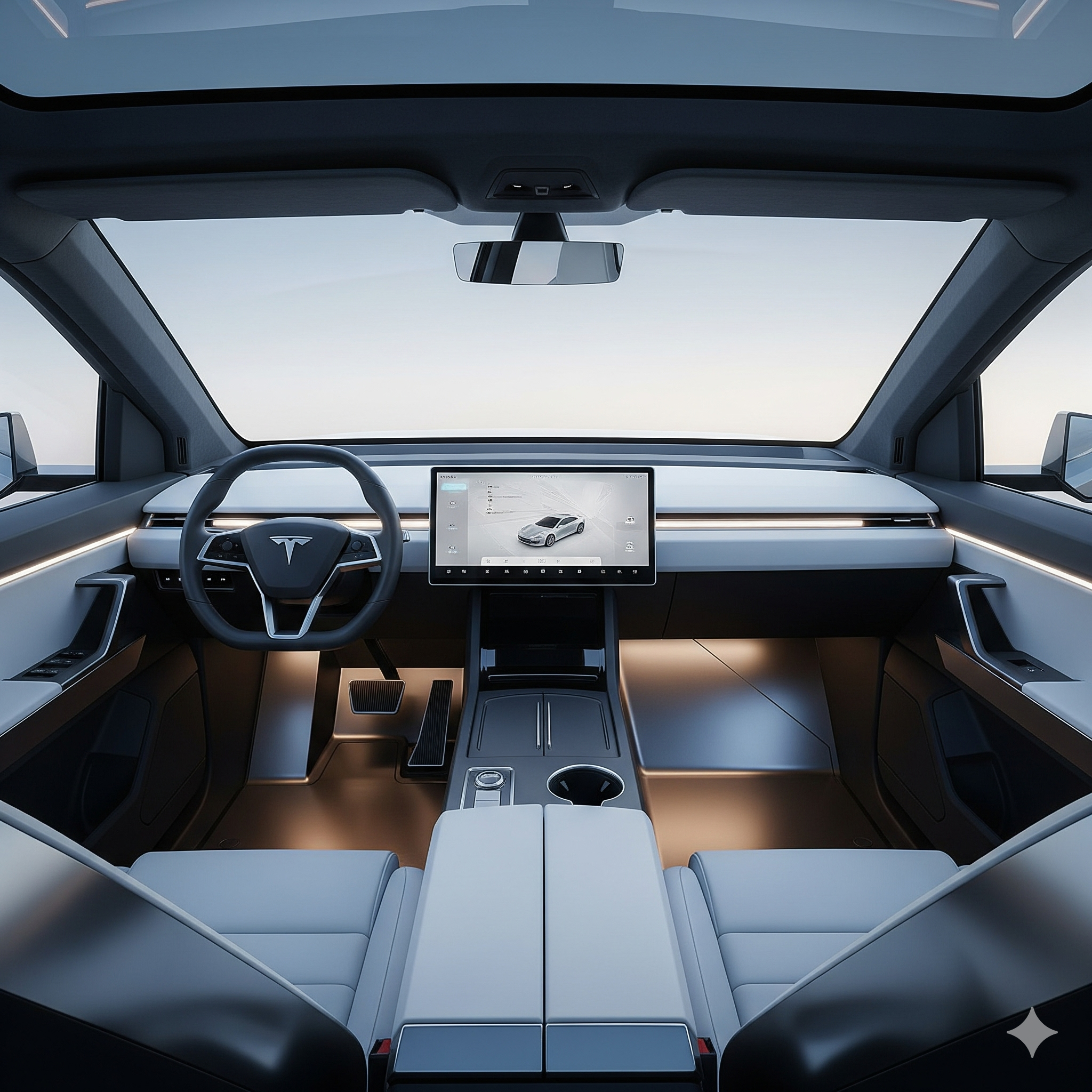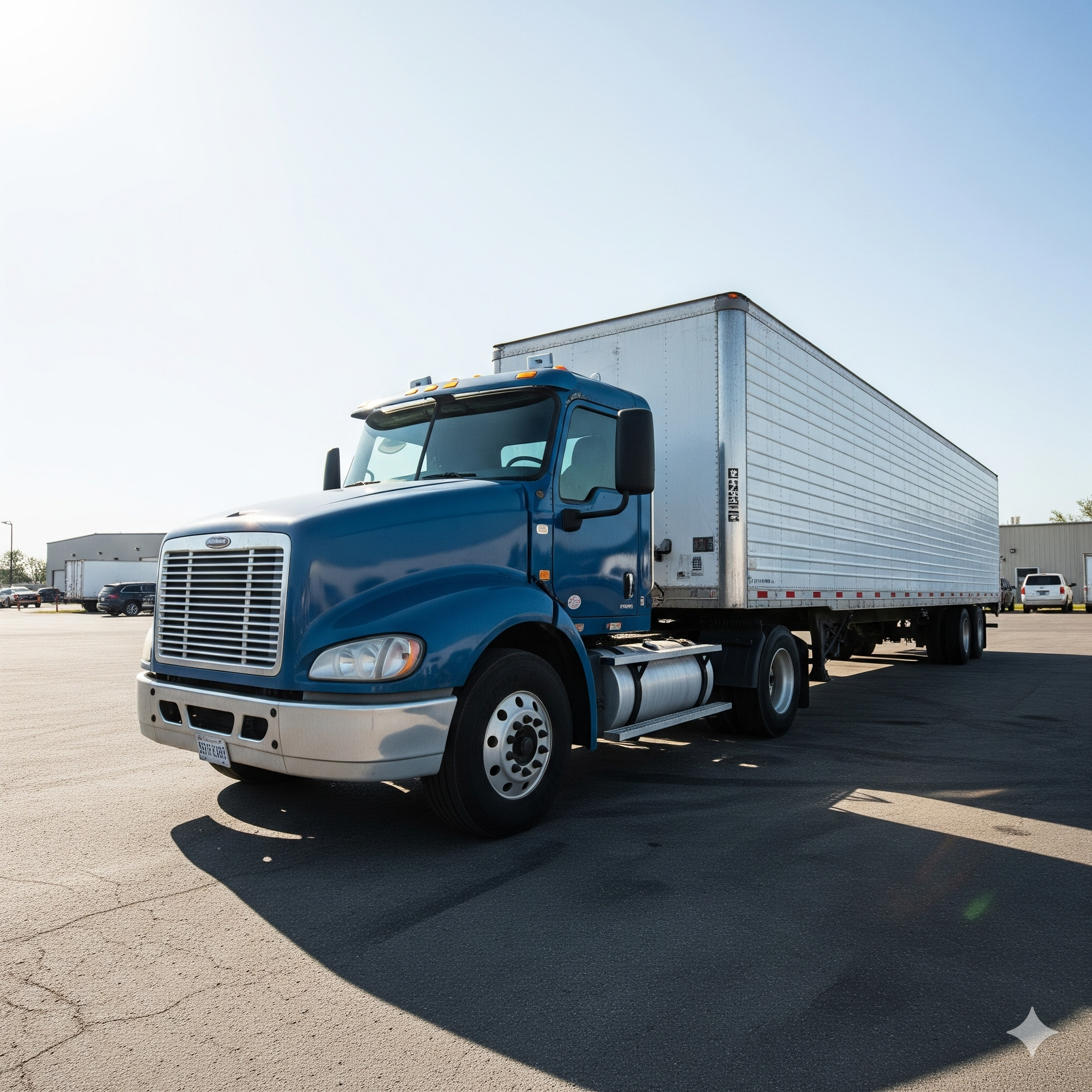When Tesla first revealed the Cybertruck, most people talked about the body. The sharp edges. The stainless steel skin. The futuristic design that looked more like a movie prop than something rolling off an assembly line. But if you look past the outside, there’s another story to tell—the inside. The cabin is where drivers and passengers spend their time, and it’s packed with ideas that are as bold as the exterior.
This is a deep look at what it feels like to sit in the Cybertruck, how the design pushes limits, and why it may change the way we think about the inside of a vehicle.
First Impressions
Open the door and you immediately sense something different. The usual clutter of switches, knobs, and textured panels isn’t there. The layout is clean, with broad surfaces and sharp lines that echo the truck’s outer shell. Step in, and the seating position feels familiar to anyone who’s driven a large pickup—tall, commanding, and with a wide view of the road ahead.
The difference is in the atmosphere. Instead of trying to look rugged or luxurious, the cabin goes for a futuristic calm. It feels part spaceship, part living room. That’s intentional. Tesla wanted a space that feels unlike any other pickup, and it shows from the moment you slide behind the wheel.
Materials That Break the Mold
The cabin doesn’t use the traditional mix of leather, chrome, and wood. Instead, Tesla experimented with materials that fit the futuristic theme. The dash, for example, has a marble-like surface that is actually made from compressed paper composite. It looks like polished stone but is sustainable and lightweight.
Seats are covered in durable synthetic material. They’re smooth, supportive, and easy to clean—important for a truck that might see mud, dirt, and work gear on a regular basis. The floor is flat and simple, with rubberized mats that feel more practical than plush carpet.
Everything seems chosen with both style and purpose in mind. The message is clear: this is a truck built for tomorrow, and the cabin needs to reflect that.
The Dashboard and Controls
The first thing you notice is the absence of traditional gauges. Instead, there’s a massive 18.5-inch center screen that controls almost everything. From navigation to climate settings, it all runs through the display. If you’ve used a Tesla before, this will feel familiar. If not, it takes some adjustment.
The steering wheel is another standout. Instead of a full round wheel, Tesla opted for a squared-off yoke-style design. It feels more like something out of an aircraft than a pickup. Drivers have mixed feelings about it—some love the futuristic look and feel, while others miss the classic round grip.
There’s minimal clutter. Air vents are hidden within slim openings, so you don’t see big plastic grilles. Buttons are scarce. The result is a cabin that feels almost empty compared to traditional trucks, but that emptiness is part of the vision.
Space and Seating
The truck seats up to six people, thanks to a front bench option. The middle seat in the front row doubles as a fold-down armrest with storage when not in use. In the back, passengers get plenty of legroom and headroom. The flat roof and squared design make it feel roomy, without the curves that sometimes eat into space in other trucks.
Storage options are plentiful. Under-seat bins, a large center console, and clever cubbies make it practical for daily use. The rear seats fold down, offering even more space if you need to carry gear inside instead of in the bed.
Practicality is a big part of the design. Tesla knows that a truck has to be more than stylish—it has to work. The seating layout makes it clear they thought about both comfort and utility.
Technology Everywhere
The cabin is packed with technology. Beyond the central display, there’s a second screen for rear passengers. It handles entertainment, climate settings, and other controls. Everyone in the vehicle can interact with the system in some way.
Connectivity is strong too. Multiple USB-C ports, wireless charging pads, and Wi-Fi keep devices powered and connected. Tesla also includes a premium audio system with impressive clarity. The design puts speakers in hidden locations, making the sound feel immersive without obvious hardware sticking out.
Over-the-air updates mean the system is never static. Features can be added, improved, or tweaked through software, keeping the interior experience fresh long after purchase.
Driving Experience from the Cabin
The cabin shapes how the truck feels on the road. With the massive glass windshield and high seating, visibility is excellent. The ride is quiet, helped by the electric powertrain and insulation. Road noise is muted, so conversations are easy, and the audio system sounds crisp.
The screen-based controls take getting used to. Adjusting mirrors, steering settings, or even the air vents requires interaction with the display. For some, this level of digital control feels advanced. For others, it can be distracting compared to physical knobs.
Tesla’s driver-assistance system, including Autopilot, integrates seamlessly with the display. On long trips, the interior becomes more than a driver’s seat—it feels like a tech-assisted lounge.
Design Philosophy
Tesla didn’t design this cabin to please everyone. Traditional truck buyers may find it too minimalist. Others may love the futuristic approach. The interior is a reflection of the larger mission: to rethink what a vehicle should be.
This is not about adding more layers of comfort in the usual way. It’s about stripping things back, simplifying, and letting technology carry the load. The result is polarizing, but it’s also original.
How It Compares to Other Trucks
Sit inside a Ford F-150 or a Chevrolet Silverado and you get a familiar mix of leather, chrome, switches, and dials. These interiors feel warm, traditional, and proven. The Cybertruck feels like it belongs to a different category.
In terms of space, it matches up well. Comfort is comparable too, though the seating materials feel less plush than premium trims from competitors. Where it separates itself is in the philosophy. Tesla isn’t trying to mimic the truck market—it’s trying to create a new one.
For someone who wants tradition, the change may be too much. But for someone seeking a fresh take, the contrast is refreshing.
Living With It
How does it feel day to day? Owners report that the simple layout makes it easy to keep clean. The seats handle spills and dirt better than traditional leather. The storage spaces prove useful for both work gear and personal items.
The reliance on the screen can still be a challenge in quick situations, like adjusting settings while driving. But over time, many adapt and even prefer the sleek control system. The interior doesn’t just look futuristic—it asks you to change habits too.
Why the Cybertruck Interior Matters
The cabin is more than a design statement. It’s a test of how far people are willing to go in rethinking what a vehicle should feel like inside. Tesla has taken risks, and those risks are part of its identity.
By focusing on space, simplicity, and technology, it challenges the idea that a truck must follow the same formula as its competitors. The cybertruck interior isn’t just about seats and screens—it’s about vision.
A Human-Centered Approach
For all the tech, it still feels built around people. The tall glass roof, the wide seats, the hidden vents—all are meant to make time inside more pleasant. Even if the style is unconventional, the function is clear.
Whether you’re commuting, road-tripping, or hauling tools, the cabin adapts. It’s not perfect, but it feels alive in a way most truck interiors don’t.
The Future of Interiors
Automakers often take small steps in design. Tesla took a leap. The choices inside this truck will likely influence future models from other brands. Minimalism, large central displays, sustainable materials—these ideas will spread.
It’s not just about being different for the sake of it. It’s about pointing to where cars and trucks might be headed. If the cybertruck interior feels unusual now, it may feel normal in a decade.
Personal Connection
When you sit in it, you get the sense that this cabin isn’t built only for utility. It’s built to make you think about what driving can be. The flat surfaces, the futuristic lines, the silence on the road—it changes how you relate to a truck.
It invites curiosity. Friends who climb in for the first time look around, touch the dash, and ask questions. It’s not just a ride; it’s a conversation starter.
Strengths and Shortcomings
Like any bold design, it has strengths and weaknesses.
Strengths:
-
Spacious and practical
-
Unique material choices
-
Cutting-edge technology
-
Clean, futuristic aesthetic
-
Easy to clean and maintain
Weaknesses:
-
Overreliance on the central screen
-
Yoke steering wheel isn’t for everyone
-
Some may miss traditional luxury touches
-
Minimalism can feel cold to certain buyers
The balance between innovation and comfort isn’t perfect. But it’s hard to deny that the cabin makes a lasting impression.
Looking Ahead
As more trucks hit the market with hybrid and electric powertrains, interiors will matter more than ever. Technology and comfort are becoming as important as horsepower and towing. Tesla recognized this early.
The cybertruck interior shows what happens when a company decides to reinvent instead of refine. Whether you love it or not, it sets a benchmark for daring design.
Final Thoughts
The Cybertruck’s body may grab headlines, but the real story unfolds when you step inside. The cabin is a blend of minimalism, technology, and practicality. It challenges traditions while offering a glimpse into the future.
It may not win everyone over, but it doesn’t need to. Its job is to set a new direction. For many drivers, the cybertruck interior will feel like a window into tomorrow.





Leave a Reply